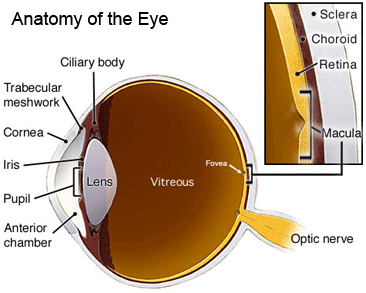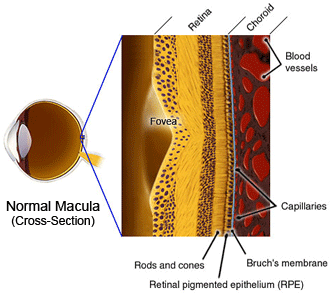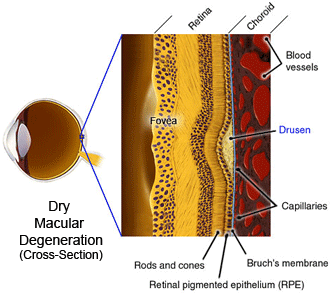Macular Degeneration

Few people are aware that macular degeneration is an incurable eye disease and that it is the leading cause of blindness for those aged 55 and older in the United States, affecting more than 10 million Americans.
Macular degeneration is caused by the deterioration of the central portion of the retina, the inside back layer of the eye that records the images we see and sends them via the optic nerve from the eye to the brain. The retina's central portion, known as the macula, is responsible for focusing central vision in the eye, and it controls our ability to read, drive a car, recognize faces or colors, and see objects in fine detail.
"Macular degeneration is the leading cause of blindness affecting more Americans than cataracts and glaucoma combined."
Age-related macular degeneration is the leading cause of blindness in the United States and many European countries. The neovascular "wet" form of the disease is responsible for most (90%) severe loss of vision. There are approximately 200,000 new cases of wet macular degeneration in the United States each year. Download your FREE Macular Prevention Guide & Test (PDF) This document requires Adobe® Reader® to view. If you do not have this installed on your computer, you can get it free from adobe by clicking here.

The average age of patients with the wet form of macular degeneration is the mid-70s. It rarely occurs before the age of 50. Wet macular degeneration is more common in whites, but occurs in all races.
The wet form of macular degeneration is usually associated with aging, but other diseases which can cause wet macular degeneration include high myopia (being very nearsighted) and some intraocular infections like histoplasmosis.
The first proven treatment was laser photocoagulation, but only 10-15% of eyes with wet macular degeneration are treatable with laser. Then recurrences after laser treatment are common (70% in 5 years). The average visual acuity 3 years after treatment is usually 20/200 to 20/250.
Patients rarely lose all of their vision from macular degeneration. Though they have poor central vision, most can walk around, dress themselves, and perform many of their normal daily tasks.
There are two types of Macular Degeneration

| Dry macular degeneration, in which the cells of the macula slowly begin to break down, is diagnosed in 90 percent of the cases. Yellow deposits called "drusen" form under the retina between the retinal pigmented epithelium (RPE) and Bruch's membrane, which supports the retina. Drusen deposits are "debris" associated with compromised cell metabolism in the RPE and are often the first sign of macular degeneration. Eventually, there is a deterioration of the macular regions associated with the drusen deposits resulting in a spotty loss of "straight ahead" vision. |

Wet macular degeneration occurs when abnormal blood vessels grow behind the macula, then bleed. There is a breakdown in Bruch's membrane, which usually occurs near drusen deposits and this is where the new blood vessel growth occurs (neovascularization). These vessels are very fragile and leak fluid and blood (hence ‘wet'), resulting in scarring of the macula and the potential for rapid, severe damage. "Straight ahead" vision can become distorted or lost entirely in a short period of time, sometimes within days. Wet macular degeneration accounts for approximately 10% of the cases, however it results in 90% of the legal blindness.

